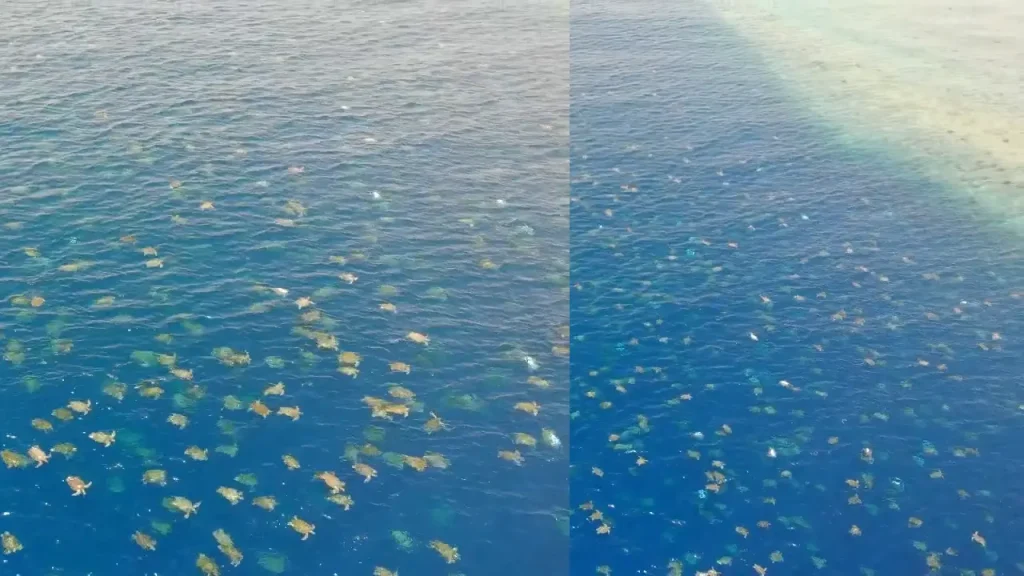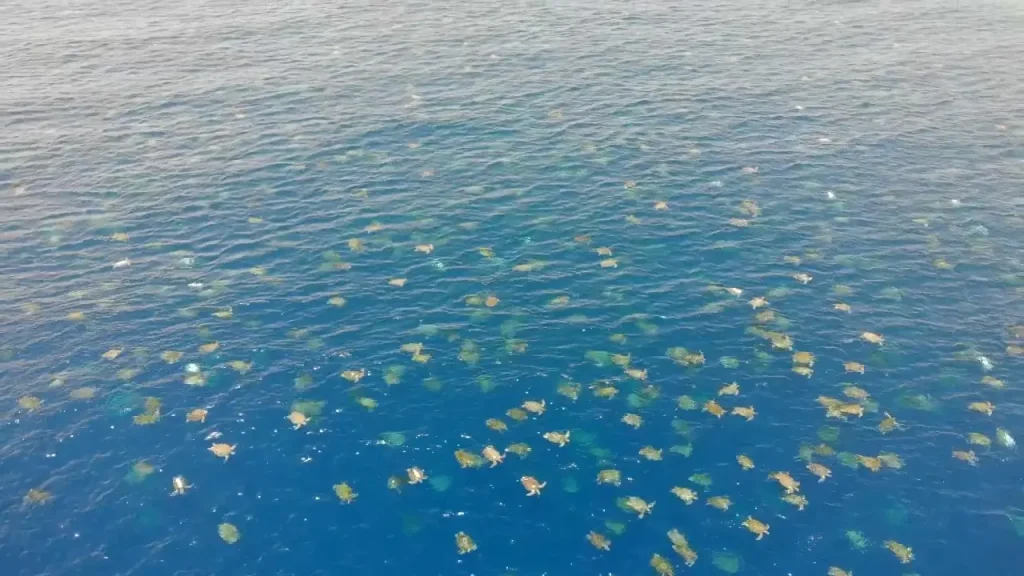Picture a drone flying with a buzz over the blue waters of the Great Barrier Reef. Down there, one can witness an incredible show – tens of thousands of green turtles with speckled shells gather on the sandy coast of Raine Island. This is not an ordinary view; it is one of the most magnificent spectacles in nature, aerial photography that is very clear and detailed. Located in the extreme north of Great Barrier Reef, Raine Island rises to prominence as a critical breeding ground for green turtles, which is home to the largest rookery of green turtles in the world. Every year, these archaic sailors swim for months back to the shores where they were born, repeating a cycle that has gone on for millions of years.

Image Credit: Great Barrier Reef Foundation
1. The Phenomenon of Turtle Migration
1.1. Description of Turtle Migration
Green turtles are known to travel hundreds, if not thousands, of miles each year to lay their eggs at Raine Island. This tiny piece of land is located on the map of the Great Barrier Reef and serves as a guide for these animals. The turtles come here due to a program that has been coded deep into their genes. They return to the same place to lay eggs as they themselves were hatched from, symbolizing the cycle of life, which has remained unaltered for centuries.

Image Credit: Great Barrier Reef Foundation
1.2. Significance of the Event
What happens at Raine Island is not just a wonder of the natural world; it is a biological and ecological phenomenon of immense importance. From a biological perspective, this migration enables the replenishment of the green turtle’s gene pool to enhance the health of the species. From an ecological perspective, these turtles are vital to the ecology of the island since their eggs and hatchlings are a source of nutrients to the sandy beaches. Furthermore, these turtles are beneficial to the overall marine environment in relation to the condition of coral reefs and seagrass beds surrounding the island.
2. Raine Island Recovery Project
2.1. Introduction to the Project
The Raine Island Recovery Project is an enormous undertaking, bringing together several parties with the same goal in mind – the protection of wildlife. They are BHP, the Queensland Government, the Great Barrier Reef Marine Park Authority, and the Wuthathi and Meriam Nation Traditional Owners. Together, they strive to maintain the environmental balance of Raine Island, which is the most important nesting site for green turtles in the world. The project’s goals are ambitious: to increase the survival of turtle hatchlings and guarantee the continuity of the turtle population.
2.2. Conservation Efforts
In order to address the threats that nesting turtles face, the project incorporates the following specific conservation measures: One of the major programs is the enhancement of nesting beaches. This is done by changing the contours of the beaches to ensure that eggs are not washed away by high tides, which may either drown the hatchlings or cause the eggs not to hatch. Also, barriers in the form of fences have been put up in specific areas to help the turtles move away from these fatal areas and avoid falling into rock gaps. These are important in the fight against the mortality rate of the turtles so that as many of the hatchlings as possible reach maturity.
3. The Role of Drone Technology in Conservation
3.1. Advantages of Using Drones
Drones have transformed the way conservationists monitor and manage populations of wildlife. For the green turtles at Raine Island, drones also prove to be safer and more accurate in monitoring the population count. It is less invasive compared to on-ground surveys which often cause discomfort or stress to the wildlife being surveyed. This helps to minimize the impacts on both the turtles and the researchers. Furthermore, drones can cover large areas at a much faster rate than humans; this implies that data collection will not only be fast but also inclusive of all the nesting grounds.

Image Credit: Great Barrier Reef Foundation
3.2. Data Collection and Usage
The information gathered through drones is also diverse and comprehensive and includes clear images and videos that capture the extent and distribution of turtle nests. This information is then compiled and stored in secure databases where researchers can then compare pre and post intervention data to determine the success of conservation measures. Most importantly this information assists the scientists in understanding the patterns of nestling and potential threats to the turtles and in turn makes decisions on where best to conserve the turtles. The use of drones in data collection hence enhances the effective conservation of green turtles in Raine Island.
4. Future Technologies and AI Integration
4.1. AI Developments
The role of AI is set to deepen in wildlife conservation, especially in counting and monitoring animals such as the green turtles at Raine Island. Instead of manually analyzing the footage, AI algorithms would be able to quickly analyze the footage and count the number of turtles. This technology employs machine learning models which have been trained to identify turtle shapes and size from different perspectives hence tallying the count without bias.
4.2. Potential Impact
It is easy to see that AI could revolutionalize turtle conservation by improving the effectiveness and accuracy of research and protection measures. With AI, constant tracking becomes possible, giving immediate information on turtle migration and other population trends. This capability helps quickly respond to new threats, for example, changes in the environment or increased mortality rates. Furthermore, AI insights could help us better manage the protected areas which would mean that the resources allocated to this cause are utilized in the appropriate manner. The application of AI in the area of turtle conservation not only offers a more accurate prediction of turtles density but gives a new hope for the future of our environment.
Conclusion
The drone cinematography capturing the moving of tens of thousands of green turtles in Raine Island is not just visual novelty; it’s a breakthrough in the conservation realm. What Raine Island Recovery Project demonstrated along with the help of drones and AI technologies is a brand new era of ecological management. Such technologies are not only more safe and effective to track turtle populations but also contribute to more accurate data measurement. By persistently employing these advanced technologies in the implementation of the various conservation measures, there is hope for the green turtles at Raine Island. This project can serve as a lesson that accepting modern technology makes it possible to use conservative methods for the preservation of endangered species and significant natural sites.
You may be interested in reading this article: A fully preserved 39,500-year-old cave bear found in the Siberian permafrost, We also invite you to explore more of our captivating content on our channel. Double muak!
